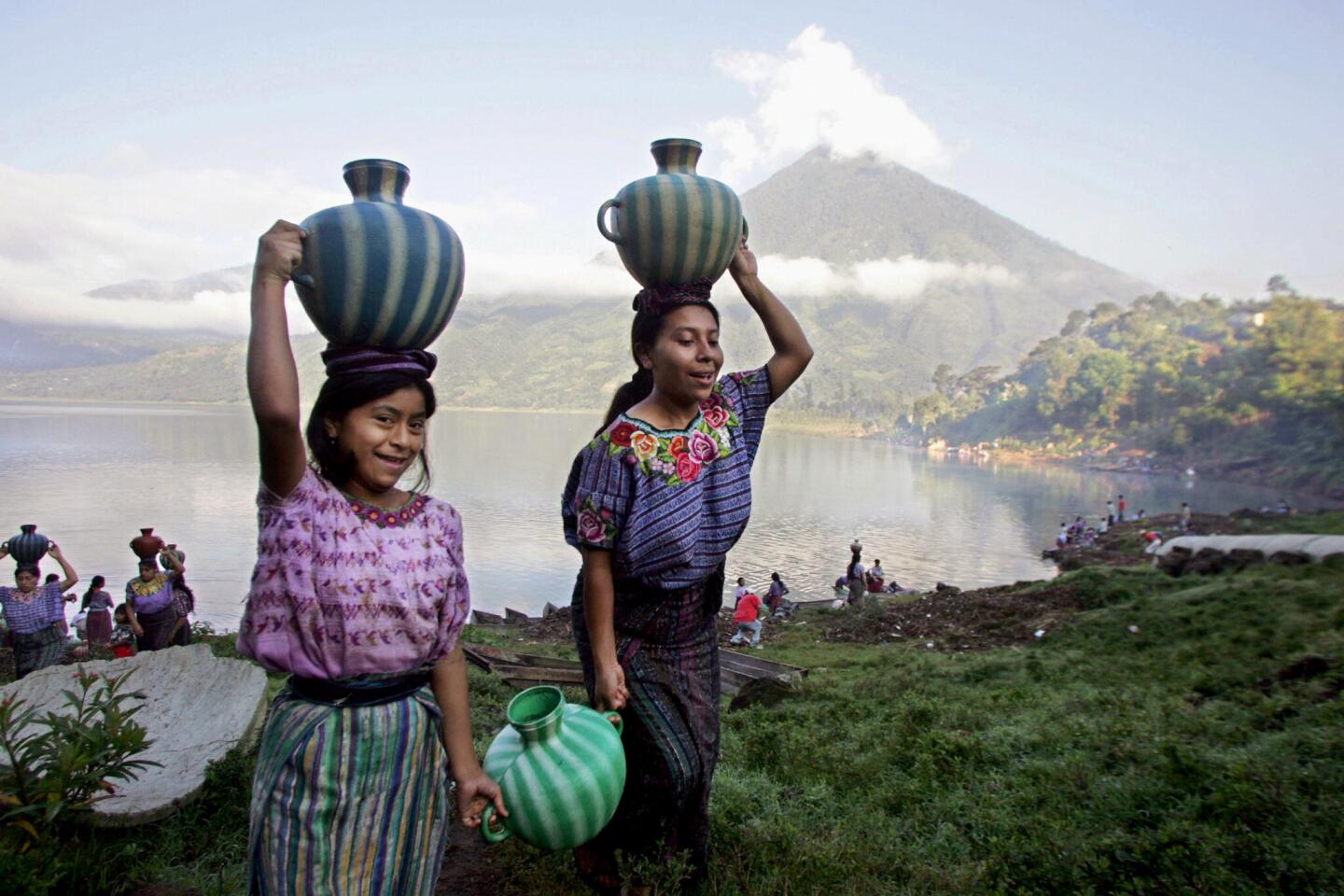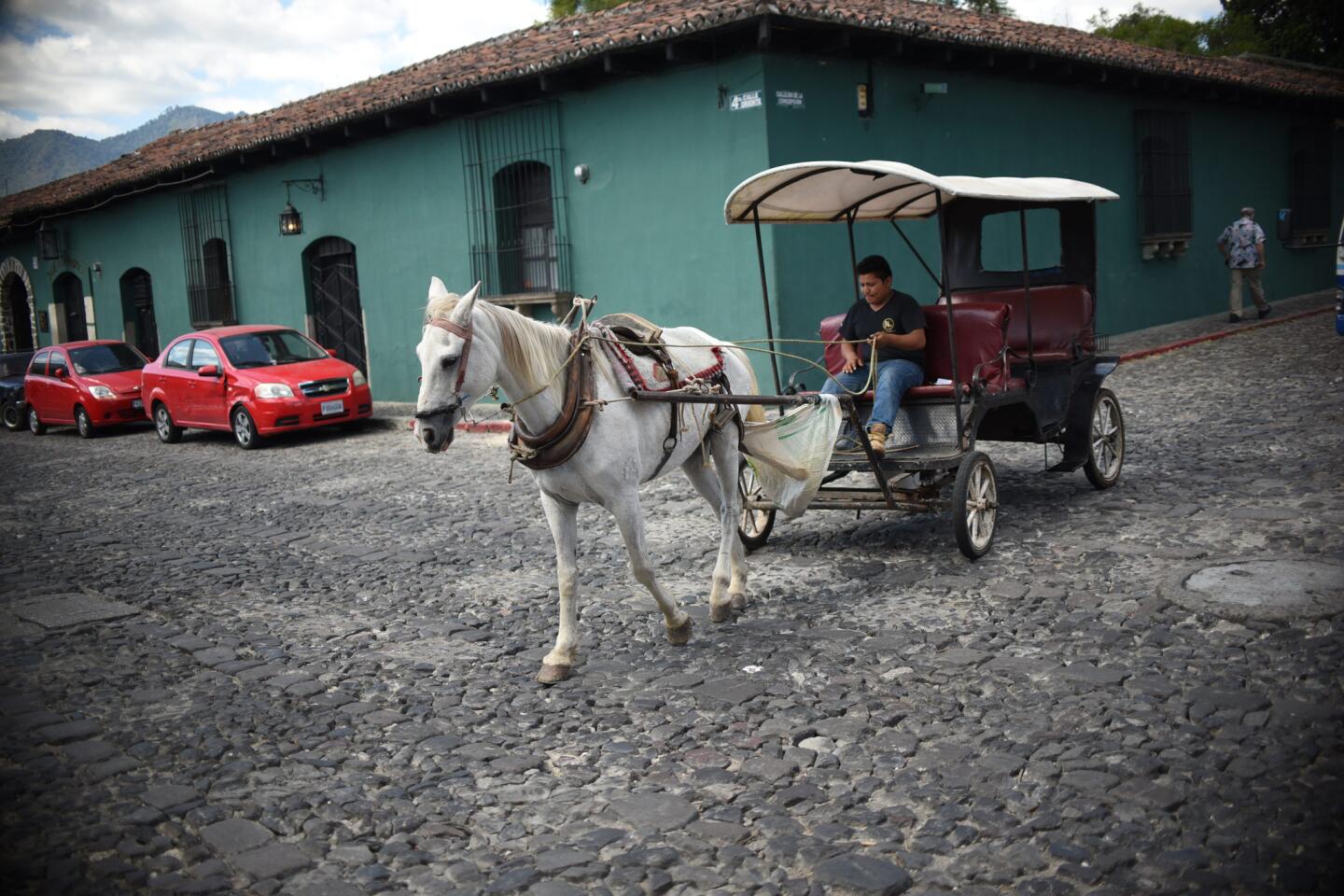Just say sí: A family spends a month in Guatemala trying to learn the language — but did it work?
- Share via
Reporting from San Pedro la Laguna, Guatemala — In the shade of my thatch cabana classroom, I beamed as my children, ages 6 and 9, serenaded me.
Reid, my younger son, shook the maracas, his older brother, Liam, beat a colorfully painted drum made from an old paint can, and their Spanish teacher strummed a ukulele.
Of course, I recognized the song — it was “La Cucaracha” — and I laughed as they sang a verse about a lady cockroach and her scarf.
The truth was I didn’t understand all of the Spanish my children had learned after just three weeks of language lessons.
In the distance, Lake Atitlán sparkled, and directly behind the kids, the garden at the language school overflowed with banana trees, red geraniums, palms, bougainvillea vines and zinnias.
I leaned back in my chair and smiled. Here I was in Guatemala — the land of eternal spring — fulfilling my dream of immersing not just myself but my entire family in the Spanish language.
In July my husband and I traveled with our children to the Guatemalan highlands for a month of Spanish lessons and a home stay with a Maya family.
We are seasoned travelers. Between the two adults we had lived in six countries and studied four non-English languages, but Spanish was not one of them.
We were eager to expose our kids to a second language, so we dedicated a month to learning Spanish, the second most-spoken language in the United States.
Spain was an option for language immersion, but many of our friends who had traveled throughout the Spanish-speaking world cited Guatemala as a highlight of their adventures.
My research into Spanish-language schools was even more persuasive: Guatemala offered a neutral accent, relatively slow speech and abundant options for highly affordable one-on-one instruction.
In our search for the right school, we had considered Quetzaltenango, Guatemala’s second-largest city appreciated by “serious” Spanish learners for its few tourists and an immersive learning environment.
We also took a long look at Antigua, a UNESCO World Heritage site known for its Spanish-Baroque architecture.
But after clarifying our goals — a school known for high-quality instruction, a home stay where our family would be the only guests (not always the case in Antigua with its many visitors) and a beautiful setting where we would feel safe at all hours — we chose a school on Lake Atitlán.
Atitlán is Central America’s deepest and, some would say, most beautiful lake, settled in a caldera, flanked by three volcanoes and surrounded by several Maya villages.
San Pedro la Laguna, a town of steep cobblestone pedestrian roads connecting touristed lakeside restaurants with Maya neighborhoods and an open-air market, proved to be the ideal learning environment for our family.
La clase de español
To get to our language school every morning we hurried from our home stay down a dirt alley and past modest shops with hand-painted signs advertising fresh beans and tortillas.
Once at school, we headed for our individual classroom cabanas for four hours of instruction. My husband and I each studied with private tutors, and our kids shared an instructor.
My teacher, Ana Maria, showed up each day dressed to the nines in a beautiful plaid Guatemalan wrap skirt, an intricate hand-woven cotton belt and a huipil blouse embellished with her impressive embroidery: one day brown and orange lilies the size of my palm, the next yellow and purple daisies set on a blue striped background.
Ana Maria could recite 13 detailed rules meant to help me decipher the vexing Spanish prepositions por and para, and she conjugated verbs like a champion.
She also turned out to be a great conversationalist. We soon discovered we had a good deal in common. Both of us were 40-year-old women struggling to balance the needs of our families with our professional ambitions.
Despite my rudimentary Spanish, Ana Maria soon had us chatting about politics, midwives, climate change and different approaches to marital mismatches. The hours of instruction flew by, and my grasp of Spanish grew quickly.
Meanwhile, my kids and their teacher, Esther, helped the school’s elderly gardener transplant Mexican shrimp plants. They sang Spanish nursery rhymes, chased each other with water balloons, made tissue-paper kites and toured around town, using sock puppets to identify what they saw in Spanish.
Maya home stay
After morning classes, Anita, our “sugar mama,” as she called herself, welcomed us home as she put the finishing touches on lunch, steaming corn-husk-wrapped tamales, seasoning guacamole or squeezing limes from the tree in the garden for juice.
I had worried about the disruption our family would cause in a stranger’s home, but Anita didn’t flinch, with four children of her own and a neighborhood populated predominantly by relatives who flowed in and out of her house.
Three times a day she welcomed us to the family table, carved with the 20 Maya calendar signs. She taught us to chime “buen provecho,” the Spanish equivalent of bon appétit, as family members came and went.
Meanwhile, the family’s smiling grandmother taught us simple greetings in the local Maya language, and the philosophical father kept us lingering at the table with conversations about Maya spirituality and the effects of Spanish colonialism on San Pedro.
All the while, Anita laughed and plied us with steaming corn tortillas.
The family’s living standards were simple. Municipal water filled the house’s cistern only three times a week, meaning showers were short. Like most women in San Pedro, Anita did the family’s laundry in the lake.
Nevertheless, the generous adjustments our hosts had made to their home to make foreign guests like us comfortable were clear: Wi-Fi, commercially purified drinking water and two spacious private rooms with doors that locked.
We embraced what simplicity remained, teaching the kids to chip in with dishwashing done in plastic basins in the garden and appreciating sunsets and evening views of the lake and its volcanoes from the home’s third-story rooftop.
Atitlán adventures
In the late afternoons we enjoyed school-organized activities, including salsa dance lessons, a seminar on the Maya calendar, kayaking and a tour of a coffee cooperative.
Other afternoons, we chatted with neighbors as we watched our kids play street soccer in the cobblestone alleyways.
Weekends we practiced spinning thread and helped dye locally grown cotton with coconut shells, hibiscus flowers and basil at a weaving cooperative.
Later, in the neighboring village of San Juan, we ducked into the cool shade of galleries glowing with famed Atitlán-style oil paintings depicting farmers picking red coffee beans, landscapes with the lake’s three majestic volcanoes looming in the background, and markets brimming with bananas, papaya and avocados.
We made use of the lake’s impressive water taxi system to visit lakeside villages, hiking along a sun-bathed cliff between Jaibalito and Santa Cruz, and platform diving into the lake in the new-agey village of San Marcos.
By our last weekend, we had managed to visit only half the lakeside attractions I had hoped to, but instead of hopping on yet another water taxi, we spent the day with our host family, visiting their jungly ancestral land partway up the San Pedro volcano and sharing in a picnic lunch.
“Buen provecho,” we hummed, giving thanks for the food, but, more than that, thanks for a month of wonderful company.
Lessons learned
We were glad to bypass Guatemala City altogether after heeding repeated safety warnings to avoid the capital city.
We had booked a taxi to drive us an hour to a guesthouse in Antigua. The journey was painless, and we were rewarded with nighttime views of lava flowing down Volcán de Fuego in the distance as well as a gorgeous and safe colonial city to explore the next day before we proceeded to San Pedro la Laguna.
What we hadn’t considered is how exhausting four hours a day of one-on-one language instruction can be.
We kept a busy pace on our first afternoons, hiking up steep roads to watch a soccer game at the local stadium and dragging the kids out into the streets, insisting they practice their Spanish with vendors if they wanted a snack. The result: tears.
We took cues from our host mother, Anita, who enjoyed an afternoon siesta whenever she got the chance. For us adults, this meant quiet homework or reading time while the kids watched Spanish cartoons with their host sister.
Our final lesson learned meant ensuring Spanish language school was as rewarding for our kids as it was for us adults.
We grown-ups loved our school’s style of instruction — progressive grammar lessons masterfully blended into conversation — we preferred that our kids, particularly our younger son who had just finished kindergarten, not take notes about gendered nouns or verb conjugations.
We were delighted when the children moved on to more immersive activities with their teacher, including water-balloon fights, field trips to the market and kite building.
Our recommendation: If you’re taking kids along for a language-school adventure, be clear that you are not looking for grammar lessons for the children.
Instead, state a preference for storytelling, art, games, singing, exploring — anything engaging, really, only in Spanish.
If you go
THE BEST WAY TO SAN PEDRO LA LAGUNA, GUATEMALA
From LAX, Delta and Lacsa offer nonstop service to Guatelamala City; Lacsa, United, American, Aeromexico, Delta and Copa offer connecting service (change of planes). Restricted round-trip fares from $605, including taxes and fees.
For the four-hour drive from the airport to San Pedro la Laguna, the Cooperativa School offers private transportation for $120 for one or two people. Travelers with more time can break up the trip by spending a weekend in Antigua before taking a shuttle ($10 per person) to San Pedro.
TELEPHONES
To call the numbers below from the U.S., dial 011 (the international dialing code), 502 (the country code for Guatemala) and the local eight-digit number.
WHERE TO STUDY
Cooperativa Spanish School, San Pedro la Laguna; 7721-8214, www.cooperativeschoolsanpedro.edu.gt. Four hours per weekday of individual instruction, afternoon activities, a home stay and three meals a day cost $205 per person, per week.
Other respected schools in the region include:
San Pedro Spanish School, San Pedro la Laguna; 7721-8193, www.sanpedrospanishschool.org
Don Pedro de Alvarado Spanish School, Antigua; 7882-4575, www.donpedrospanishschool.com
Antigüeña Spanish Academy, Antigua; 5735-4638, www.spanishacademyantiguena.com.
WHERE TO STAY
Home stays, included in the weekly language school price, offer the most immersive and affordable room-and-board option, but some students choose more private lodging.
Hotel Sak’cari, San Pedro; 7721-8096, www.hotel-sakcari.com. Solar-heated pool, lakeside garden and rooms ranging from basic doubles ($46 per night) to fully furnished apartments ($100 per night).
Yellow House, Antigua; 7882-4699, www.guatetravel.com. Spotless, centrally located hostel with attached travel agency. Doubles $30, including plentiful breakfast.
WHERE TO EAT
Host families provide three meals a day, six days a week. On Sundays, or for afternoon snacks, enjoy these San Pedro restaurants, where prices average $2 for snacks and $5 for lunch:
Idea Connection, 7a. Avenida, San Pedro; www.lat.ms/ideaconnection. Italian-run restaurant offering lunch and breakfast, as well as croissants and coffee.
Clover Restaurant, 7a. Avenida, San Pedro. Irish-themed restaurant offering delicious fruit smoothies, Asian and Western-style food.
The Fifth-Dimension Café, 8th Calle, San Pedro; 5915-0795, www.lat.ms/fifthdimension. Innovative vegetarian menu, funky murals and a rooftop view of the lake.
WHAT TO DO
Lake Atitlán Guatemalan Cooking Class and Weaving Cooperative Tour, San Pedro; 5824-7440, mayankitchen.com. Classes include a trip to the market, cooking Maya dishes such as plantain mole, and basic weaving and dying instruction ($35 per person).
Cerro Tzankujil Nature Reserve, San Marcos. Platform diving and swimming from well-maintained lakeside trails ($2 entry).
Maya Tzutujil Travel Center, San Pedro; 4770-7990, www.mayatravelsanpedro.com. Tour center offering shared shuttles to Antigua ($10 per person), and guides for the full-day ascent of San Pedro or the more moderate Indian’s Nose hike (from $20 per person). No guide is needed for the hour-long, lakeside hike between Jaibalito and Santa Cruz, or for visiting galleries in San Juan, though a lake taxi is required ($1-3 each way).
TO LEARN MORE
Visit Guatemala, visitguatemala.com/en
More to Read
Sign up for The Wild
We’ll help you find the best places to hike, bike and run, as well as the perfect silent spots for meditation and yoga.
You may occasionally receive promotional content from the Los Angeles Times.








